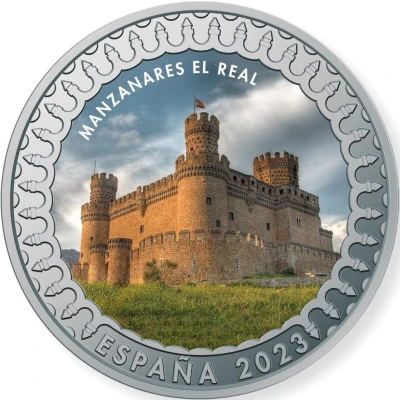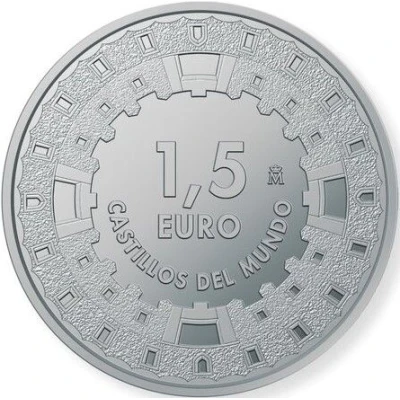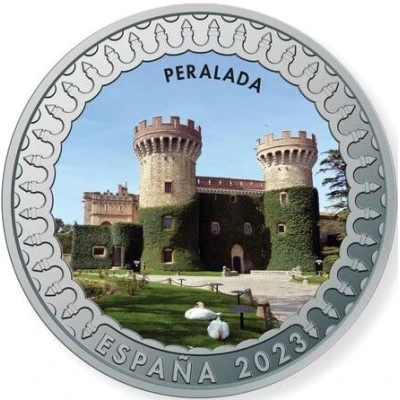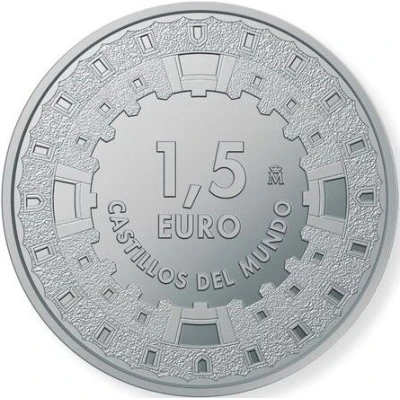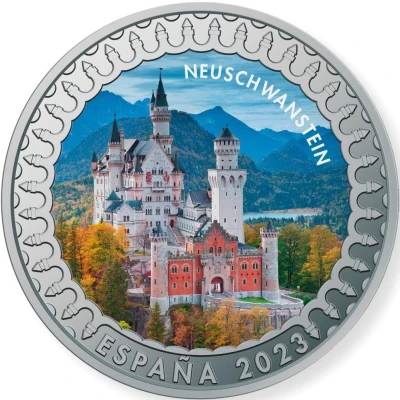
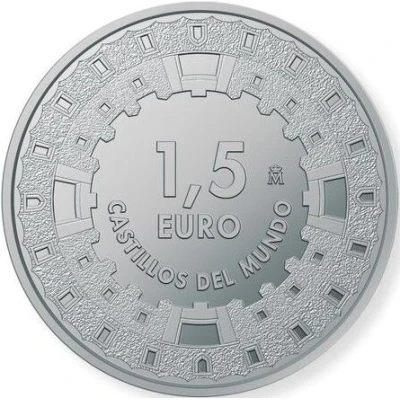

© Real Casa de la Moneda
1.5 Euro Castle of Neuschwanstein
2023 year| Copper-nickel (75% copper, 25% nickel) | 15 g | 33 mm |
| Issuer | Spain |
|---|---|
| King | Felipe VI (2014-date) |
| Type | Non-circulating coin |
| Year | 2023 |
| Value | 1.5 Euro 1.50 EUR = USD 1.65 |
| Currency | Euro (2002-date) |
| Composition | Copper-nickel (75% copper, 25% nickel) |
| Weight | 15 g |
| Diameter | 33 mm |
| Shape | Round |
| Technique | Milled, Coloured |
| Orientation | Medal alignment ↑↑ |
| Updated | 2024-10-07 |
| Numista | N#383804 |
|---|---|
| Rarity index | 97% |
Reverse
On the outside part of the the reverse (common to all the coins), allegory of the structure of the castles.
Script: Latin
Lettering:
CASTILLOS DEL MUNDO
1,5 EURO
M
Translation: Castles of the World
Edge
Plain
Comment
Neuschwanstein Castle: In 1869, King Ludwig II of Bavaria, unjustly nicknamed “Mad King Ludwig”, had the New Hohenschwangau Castle built on a huge rock in memory of the nearby palace where he had spent his childhood, and which only after his death in 1886 was renamed Neuschwanstein Castle. The castle was scarcely inhabited by its creator hardly lived there, and he never saw its completion.South of Munich, the capital of the federal state of Bavaria, and barely 5 km from the Austrian border, stands this fabulous castle of medieval appearance, the prototype of the so-called "fairytale castles”, which served as the inspiration for the castle in Charles Perrault’s classic Sleeping Beauty that was brought to the big screen in 1959 by Walt Disney.
Ludwig II of Bavaria was a reclusive and fanciful king with a strong tendency towards a romantic idealisation of life, facets that were enhanced by a life surrounded by luxury and a childhood spent amidst German sagas of medieval heroes and knights, many of them turned into operas by his great admirer and protégé, the German composer Richard Wagner.
This sentimental personality, with an idealised and distorted view of reality, was later projected onto several of the palatial residences that “Mad King Ludwig” had built during his 22-year reign. Besides Neuschwanstein Castle, Ludwig II also built Linderhof Palace, the Herrenchiemsee New Palace (modelled on the French Palace of Versailles) and the King’s House on Schachen. Each was conceived in a style of its own as fantasy-filled refuges, palaces to which he could retreat from the reality that he found both overwhelming and unbearable. Ludwig II was a king who lived by night and slept by day.
The plans for Neuschwanstein Castle were drawn up by the architect Eduard Riedel based on the drawings that the young Bavarian king had commissioned Christian Jank to make. From an initial idea of a late Gothic style, the building eventually turned into a monumental castle in the Romanesque style, vaguely reminiscent of Wartburg Castle.
The physical materialisation of this ideal required large sums of money, which the royal household could not afford to pay. In 1885, the threat of seizure was present. Only a year later, Ludwig II was declared unfit to rule, which led to his deposition and subsequent internment in Berg Castle, where he died shortly afterwards drowned in Lake Starnberg, together with his psychiatrist, in strange circumstances that have never been clarified.
This huge 150-metre-long complex, one of the most visited in Germany, is located in an extraordinary setting surrounded by lakes, lush forests and snow-capped peaks. It allows the visitor to enter a world verging on fantasy, and to walk through a large number of beautifully decorated rooms and halls that immerse the visitor in the great German medieval sagas that Richard Wagner drew upon to create some of his greatest works, such as Parsifal, Lohengrin and Tannhäuser. The king was so fascinated by them that some of the castle’s rooms – such as the Singers’ Hall, the Throne Hall and the Drawing Room, among others – are decorated with murals dedicated to these works.
Interesting fact
The Castle of Neuschwanstein, featured on the 1.5 Euro non-circulating coin from Spain, is a famous fairy tale castle located in Bavaria, Germany. It was built in the 19th century by King Ludwig II and is known for its unique architecture and stunning surroundings. The castle has been a popular tourist destination for many years and has been the inspiration for various fairy tales and stories, including the Disney castle.
Price
| Date | Mintage | VG | F | VF | XF | AU | UNC |
|---|---|---|---|---|---|---|---|
| 2023 M | 5000 | - | - | - | - | - | - |
Values in the table are based on evaluations by sales realized on Internet platforms. They serve as an indication only for 1.5 Euro (Castle of Neuschwanstein) 2023 coin.
